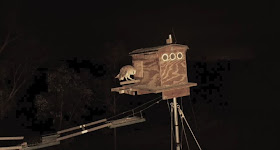The preybox was utilized and 14 treats devoured.
This owl was back again and spent a lot of time through out the night trying to figure out how to get inside the nesting box.
It went from one side to the other, over to the camera housing, up to the roof, even looking under the box looking for the entrance hole opening. At one point it tried to remove the covering with its beak.
We know that many wineries use boxes for rodent control in their fields as well as in other types of California agriculture, including pecan, walnut, and citrus groves.
They are finding barn owls to be useful additions to sustainable agriculture. Barn owl nest boxes have been erected in sugar cane fields for years, and the density of barn owls in such areas can reach astounding densities.
In one Florida sugar cane field, as many as 10 pairs of barn owls have been counted occupying a barn and several barn owl boxes located on grounds. Each of them were raising a brood. Farmers erect boxes as close as 100-200 yards apart.
Barn owls have nested close to other barn owl boxes that are in a close proximity of each other and because of the Barn Owl's unique
non-territorial behavior, there can be as many owls in an area of high pest infestation as there are boxes available for them to use.
(per The Hungry Owl Project - The Hungry Owl Project (HOP) is a partnerhsip with WildCare, a non-profit education and wildlife rehabilitation center in Marin County, CA.)




